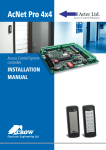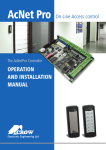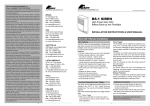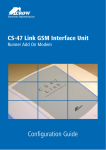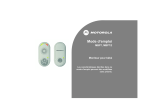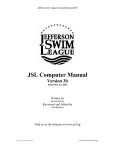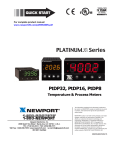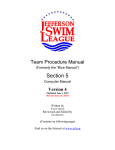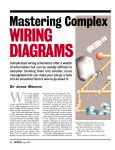Download CS47 GSM PHONE LINE BACKUP User Guide V1.00
Transcript
ELECTRONIC ENGINEERING LTD. TEL : + 972 3 556 99 37 FAX: + 972 3 559 29 81 www.thecrowgroup.com [email protected] CS47 GSM PHONE LINE BACKUP User Guide V1.00 REV. A SOFTWARE VERSION 1 12/07/04 1 INTRODUCTION .................................................................................................. 3 General Specification: ........................................................................................... 3 Basic Functionality ................................................................................................ 3 Reduction of Costs................................................................................................ 3 Password Protection ............................................................................................. 4 Operation ............................................................................................................. 4 SMS support ......................................................................................................... 4 Inputs................................................................................................................... 4 Outputs ................................................................................................................ 4 SIM card............................................................................................................... 4 Connecting the CS-47 ........................................................................................... 5 CS-47 PC software ............................................................................................... 6 Translations .......................................................................................................... 6 Software installation .............................................................................................. 6 Configuration of the CS-47 unit .............................................................................. 7 Configuring system inputs...................................................................................... 8 Defining Input Telephone Numbers ........................................................................ 8 Defining SMS Messages for Inputs......................................................................... 9 Configuring System Outputs ................................................................................ 10 Defining Output Parameters................................................................................. 10 Triggering the System ......................................................................................... 11 Configuration of the miscellaneous page .............................................................. 13 Configuration of the “ low power” message : ......................................................... 13 Configuration of the “Test message” area ............................................................. 13 Configuration of the “phone line ” area.................................................................. 14 Add prefix number............................................................................................... 15 Communication page .......................................................................................... 16 cellular dial prefix ................................................................................................ 16 communication with the unit................................................................................. 16 File Options ........................................................................................................ 17 Using the CS47 after it was installed .................................................................... 18 Sending SMS Messages ..................................................................................... 18 Output operation by SMS.................................................................................... 18 Activating and Deactivating the System ................................................................ 19 Changing the User Password .............................................................................. 19 Handling Received SMS Messages ...................................................................... 19 2 1 INTRODUCTION The CS-47 is a cellular backup to PSTN phone line system. When connected to an alarm control panel, the CS-47 operates as a GSM back up unit to a PSTN line, enabling to re-direct incoming and outgoing calls to the GSM network in case of regular phone line failure. 1.1 General Specification: • Built-in Tri-Band GSM transceiver • Continuous PSTN line supervision • GSM backup at PSTN Line failure • Programmable SMS messages • Multi language support for SMS and for PC graphical interface • 4 inputs for SMS and output operation • 4 outputs operated either locally or by SMS • Battery backup support including charger • Status report by SMS messages • Cheaper call routing to GSM when dialing to a cellular number 1.2 Basic Functionality The Mobile Bridge provides operators the means to connect to various inputs and output devices. It uses cellular technology to send and receive messages, allowing operators to monitor and control the required devices. For example, the Mobile Bridge sends an SMS to the security center if an office has been ente red without authorization. 1.3 Reduction of Costs With the CS-47, all telephone landlines (PSTN) are routed through the CS-47 unit, together with the cellular modem that is connected to the CS47. Certain telephone calls are then routed through the CS-47 modem. This reduces costs on these telephone calls, because the System automatically selects the least expensive route and diverts calls to either the landline or the cellular line, as relevant. The switch is according to a programmable prefix number, when the unit detects this prefix number that was programmed it switches the call to the cellular line although a PSTN line is connected. 3 1.4 Password Protection The Mobile Bridge uses two different kinds of passwords to ensure System Security: Program password –allows users defined as System Administrators to access the configuration program and change the System configuration as required. This password is not available to end-users. User password –used in SMS messages by end-users to trigger various events for the inp ut and output devices defined in the System. Both passwords must consist of four characters 1.5 Operation The system powered by 14VDC with a 12V/1.3A backup battery. The battery is recharged by the system. 1.6 SMS support The CS-47 support programmable SMS messages, the messages are programmed by Crow PC software and downloaded to the system by a DLink cable. The system support multi language SMS messages 1.7 Inputs The CM-18 offers 4 digital inputs. Every input trigger generates an SMS message to a programmed number and activates an output. 1.8 Outputs The CS-47 has 4 programmable outputs. 4 open drain FET outputs, output number 1 is also a dry contact relay in parallel. The outputs can be operated locally according to inputs triggering or by SMS ( by remote). 1.9 SIM card The CM-18 supports 1.8V / 3V / 5V SIM cards. Before entering a SIM card to the CM18 the pin code should be cancelled for that SIM card, you can cancel the pin code using any kind of mobile phone. 4 2 Connecting the CS-47 TEL-OUT: phone line output supplied to an external system, RJ11 connector or terminal block TEL-IN: PSTN phone line input (main phone line), RJ11 connector or terminal block Main power supply: 13.8 VDC supplied by external power source or panel Battery: 12V / 1.3A Antenna: dual band GSM antenna. Inputs: 4 digital inputs and a key input, in order to trigger an input you need to pull the input low (connect ground) Outputs: 4 digital open drain outputs and a dry contacts relay ( the relay is in parallel to output 1). Indication LED’s System OK led – blinking when the system is ready for use Hook off led: the led is “on” when the external system picks up the phone (goes off hook). Line OK led – light when PSTN line exists. 5 3 CS-47 PC software The CS-47 PC software is a graphical user interface (GUI) to be used in order to configure the unit. 3.1 Translations The GUI can be translated to various languages, the text and the tool tip box can be translated by translating the texts in two files in the software folder: “:\Program Files\CS47”. The files to be translated are frmedit.txt and frmEditToolTip.txt. 3.2 Software installation To install the configuration program, perform the following steps: 1. From the CD that comes with the CS47 package, double -click the setup file. 2. Follow the steps in the setup wizard to select the required location on the local hard drive. 6 Configuration of the CS-47 unit The configuration of the CS-47 can be in 3 different ways: 1. Local configuration – using crow graphical interface (PC software), connecting via D-link cable 2. Local configuration – using crow DTU board, in order to use the DTU board the configuration must be load to the board before the installation from a programmed CS47 unit 3. Remote configuration – using a cellular modem with sim card in the same network, the tool for the configuration is the PC software. Graphical User Interface The graphical user interface of the Mobile Bridge configuration wizard consists of one window with four tabs, each containing parameters to configure various options. The tabs are as follows: Input – Use to configure up to four System inputs. Output – Use to configure up to four System outputs. Miscellaneous – Use to configure general System parameters. Communication – Use to select the telephone dialing prefixe that will be recognized by the System, for least cost call routing, and for communicating with the unit. Each tab contains a number of areas. For example, the Input tab contains an area to select a specific input, an area to define the phone numbers that will receive SMS messages about the input, and an area to define the messages themselves 7 3.3 Configuring system inputs 3.3.1 Defining Input Telephone Numbers The Mobile Bridge allows the definition of up to four telephone numbers per system input. SMS messages concerning the state of the relevant input are sent to these numbers. To define the telephone numbers for each input, perform the following steps: 1. Click the Input tab. 2. From the Input Number drop-down list, select the desired input number. 3. Select the Enable checkbox next to each telephone number that will be used. 4. In the Phone Number area, enter the telephone numbers that will receive SMS messages for the relevant input number. Note: Click Copy Phones to copy these phone numbers to all other telephone input fields, for use with other inputs. 8 3.3.2 Defining SMS Messages for Inputs The Mobile Bridge allows the definition of different SMS messages to be sent, depending on the state of the input. For this reason,the Message area of the Input window contains two Message fields.These fields correspond to the two possible states of an input, which are as follows: • On –The input device is running (the input has changed from “high” to “low”) • Off –The input device is not running (the input has changed from “low” to “high”) To define the SMS messages to be sent for each input state, perform the following steps: 1.Click the Input tab. 2.In the Messages area, select the Enable checkbox for each state for which a message is to be enabled. 3.In the Message field corresponding to the enabled state, enter the SMS message to be sent. Note: The Chars Left field displays the permitted number of characters remaining for each message. This is a read-only field. 4.Define the Detect time (in seconds) for the message. The Detect time is the amount of time an event must continue in order to trigger the SMS. 5.Define the Delay time (in seconds) for the message. The Delay time is the amount of time it takes to trigger the SMS after an event has occurred. 6.Define the Repeat time (in minutes) for the message. The Repeat time is the interval at which the SMS is re-sent, if the status of the input does not change. 7. In case you need an output to be activated on an input triggering choose an output number (one of the outputs). 9 3.4 Configuring System Outputs The CS-47 allows the configuration of up to four output devices. The configuration procedure for each output device includes defining the normal status of each device. An output can be activated in two different ways: Locally – activate an output when an input is triggered. defined in the input page By SMS – activation of an output by remote using SMS messages. Selected when enabling the checkbox in the output page. Note: if one of the option selected than the other option is disabled. 3.4.1 Defining Output Parameters Defining the output parameters includes enabling or disabling each device, and defining the normal state of each. This tab also allows the System Administrator to change the user password, if necessary. To define output parameters, perform the following steps: 1.Click the Output tab. 2.To change the user password, enter the new password in the User Password field. 10 Note: The user password must consist of four characters. 3.Select the Enable checkbox for the first output to be defined.( “Enable SMS Control”) 4.Select the normal state of the output. Options are: NO – normally open: the output device is normally enabled NC – normally close: the output device is normally disabled 5.Specified Time (pulse) – if an SMS message is sent to trigger an event, specify the length of time (in seconds)for which the event will occur: a. Select the pulse checkbox. Regardless of the event that is triggered (normally open or normally closed),the pulse parameter changes the output to the opposite status for the specified duration. For example, if the output is normally open, and pulse is set for 25 seconds, the SMS message triggers an event that closes the output for 25 seconds,and then returns it to its normal state. b. Enter the number of seconds for which the event will occur. For more information about SMS activation of outputs refer to chapter : “ using the CS-47 after installation “. 3.5 Triggering the System The System parameters required for arming or disarming the company’s system include the following: Trigger type Trigger confirmation parameters Alarm message parameters In default state the system is triggered wich means it checks the inputs and sends SMS, when system is not triggered no messages will be sent. To define these System parameters, perform the following steps: 1. Click the Output tab. 2. In the Trigger System area, select the types of triggers by which the outputs can be operated. It is possible to select more than one option. Options are: · SMS · Key 3. In the Delay Time field, define the number of seconds after the system is triggered that it will actually be armed. 11 4.Select Trigger Confirmation as relevant. If it is selected, continue to Step 5 (to define the Phone Number field). If it is not selected, go to Step 8 (to define the audible alarm). 5.In the Phone Number field, enter the phone number to which an SMS will be sent confirming that the System has been triggered on or off. 6.In the Alarm off –message field, enter the text of the SMS confirming that the alarm has been disarmed. Note: This message can contain up to 15 characters, as noted in the Chars Left field. 7.In the Alarm on ±message field, enter the text of the SMS confirming that the alarm has been armed. Note: This message can contain up to 15 characters, as noted in the Chars Left field. 12 3.6 Configuration of the miscellaneous page 3.6.1 Configuration of the “ low power” message : In the Low Power area, define the parameters of the SMS message that is sent if System power drops below 9.5 volts: Select the Enable checkbox. In the Phone number field, enter the phone number to which the SMS message will be sent. In the Message field, enter the text of the SMS message. In the Interval field, enter the number of minutes at which the SMS messages will be sent. As long as this field is set to a value greater than 0, the SMS message is sent repeatedly, until the power flow returns to normal. Note: This message can contain up to 15 characters, as noted in the Chars Left field. Do the same for “power restore “ message. 3.6.2 Configuration of the “Test message” area In the “Test message” area, define the parameters of the SMS message that is sent if the System is functioning correctly. 13 Note: In order to receive messages as defined in the System OK area, the user must send the Program Password to the system. This means that only a user with the System Administrator password may activate such messages. a. Select the relevant option for sending messages. There are three possible configurations: • SMS request selected –the system sends the message at the administrator’s request. • Enable selected –the message is sent automatically at a predefined interval. • Both SMS request and Enable selected –the system sends messages both at a predefined interval, and at administrator’s request b. In the Phone number field, enter the phone number to which the SMS message will be sent. c. In the Message field, enter the text of the SMS message. d. If Enable was selected in Step 2a,the SMS message is sent repeatedly, at a predefined interval. In the Interval field, enter the number of hours at which the SMS message will be sent. Note: This message can contain up to 15 characters, as noted in the Chars Left field. 3.6.3 Configuration of the “phone line ” area In this area you define the parameters of the SMS that will be sent when the PSTN line fail and when it restores. a. Select the Enable checkbox. b. In the Phone number field, enter the phone number to which the SMS message will be sent. c. In the Message field, enter the text of the SMS message. d. In the Interval field, enter the number of minutes at which the SMS messages will be sent. As long as this field is set to a value greater than 0,the SMS message is sent repeatedly, until the power flow returns to normal. Note: This message can contain up to 15 characters, as noted in the Chars Left field. Do the same for “phone line restored “ message. 14 3.6.4 Add prefix number In case the external application dials to a phone number in the same area code it doesn’t uses a prefix number, you can have a problem since the unit dials from a cellular line and needs the prefix number. So when the number doesn’t start with a zero the unit understand that there is a prefix missing and will automatically add the programmed prefix. If the number does start with a zero that no prefix will be added a. Select the Enable checkbox. b. In the “add prefix : field write the prefix number ( area code ) 15 3.7 Communication page 3.7.1 cellular dial prefix In this area you can select a prefix number for a cheaper call routing. When the unit detect the prefix number that was programmed in this field the unit will direct the call to the GSM line although a PSTN line is connected. 3.7.2 communication with the unit “change program password” – entering a new password for programming the unit. “Program password” – In this field you have to enter the password that is already in the CS-47, if the wrong password is entered you wont be able to program the unit. “Select port “ – selecting witch serial port to use “Connection type “ - the connection to the unit can be either by RS232 serial port or by remote using a cellular modem, in this case you have to enter the number of the sim card witch is in the unit. 16 3.8 File Options There are four options for handling the file containing the configured System parameters. These options are as follows: • To CS47 – to download the configuration to the CS47. • Load File – to load a saved configuration. • Save File – to save the current configuration for later use. • From CS47 – uploads a file from the CS47 to the local computer. These buttons appear at the bottom of each window in the user interface. After configuring the System parameters as required, select the relevant option. 17 4 Using the CS47 after it was installed 4.1 Sending SMS Messages With the CS47, it is possible to send SMS messages to four different output devices, to turn the devices on or off. Note: It is only possible to send messages if the system has been so configured. Compose SMS messages to be sent to the Mobile Bridge according to the following guidelines: § Messages can be sent from any ordinary mobile phone. § Password – the system is case-sensitive; enter the password accordingly. § Messages are sent to the mobile phone number of the relevant unit § The System switches from the landline to the cellular phone only after the fourth digit (including the phone prefix) has been entered. The System must recognize the phone prefix dialed, or it will not switch to the cellular phone. § Mobile programming period • If a voice call comes in during this period, the system does not respond. Since it has switched to data mode, it will only respond to a data call. • During this period, the System waits one minute for the data call to be received. If no data call is received in this time period, the System reverts to voice mode. • After the mobile programming period is finished, the Mobile Bridge returns to Bridge mode. § Pulse configuration – if the pulse option was defined during System configuration, then SMS messages will trigger System outputs accordingly. 4.2 Output operation by SMS For messages regarding the various outputs, the message must consist of the following: User password –must be four characters (lower-case only) Output number –the number of the relevant output (1-4),as defined during System configuration (refer to “Configuring System Outputs” ). Relevant option n –turn the system on (lower-case only) f –turn the system off (lower-case only) The message may not have any spaces: (User password)(Output number)(Option) 18 Example: acac1n In this example, acac is the user password,1 is the outp ut number, and n turns the output on. 4.3 Activating and Deactivating the System Users can activate or deactivate the Mobile Bridge in one of two ways: § With a electrical switch key – activate or deactivate the System manually. § With an SMS message – activate or deactivate the System from a remote location. In this case, the SMS message must be constructed as follows: • <User Password>on – turn the system on • <User Password>off – turn the system off During the cellular programming period (the time during which SMS messages are sent to program the System), the Mobile Bridge will not function for outgoing calls. Only the landline can be used for outgoing calls during this period, which lasts for two to three minutes. However, when SMS messages are sent to control outputs, the Mobile Bridge functions as usual. Note: Spaces are not allowed in either case. 4.4 Changing the User Password To change the User Password ( Default 9999 ), send an SMS message to the system. This SMS message must consist of the following components: (Old password)(USD sign)(New password) Example: 9999$1234 In this example, 9999 is the old user password, $ is inserted as a delimiter, and 1234 is the new user password. 4.5 Handling Received SMS Messages The Mobile Bridge sends SMS messages to the user if the status of the relevant output has changed. For example, the system can be configured to send an SMS message to the user if the office door has been opened or closed without authorization. If such a message is received, the user should take whatever steps are necessary. 19 20




















